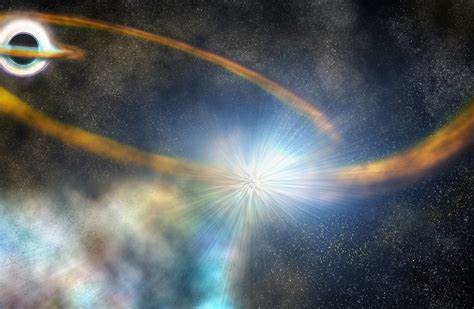June 2, 2025 — In a stunning cosmic occurrence, scientists have witnessed a supermassive black hole ripping apart a star amid a galactic collision — a rare and dramatic event that sheds light on the universe’s turbulent and energetic behavior. The discovery, described by researchers as “peculiar and powerful,” provides critical evidence of what happens when galaxies merge and their central black holes interact with surrounding stellar systems.
🌠 A Cosmic Encounter Caught in the Act
The observation was made using a combination of data from ground-based telescopes and space-based observatories. Scientists were monitoring the aftermath of a galactic merger — a phenomenon where two galaxies collide and gradually combine over millions of years. As the galactic centers approached each other, a supermassive black hole in one of the galaxies encountered a star that drifted too close.
What followed was a tidal disruption event (TDE) — an incredibly powerful phenomenon in which the immense gravitational forces of the black hole stretched and eventually pulled the star apart. The unusual event triggered an unexpected surge of electromagnetic radiation, prompting astronomers to conduct further investigation.
🔭 Rare View of a Tidal Disruption Event
Tidal disruption events are relatively rare, with only a few dozen observed in the last two decades. However, this event stands out for one major reason: it occurred within a galaxy merger, making it only the second such documented instance.
Dr. Alex Reynolds, an astrophysicist at the European Southern Observatory, noted, “This is not your average black hole feeding. It’s the cosmic equivalent of watching a lion hunt in the middle of a wildfire. The environment is chaotic, and the dynamics are extreme.”
The optical and X-ray emissions from the event were unusually strong and persistent, indicating that a substantial portion of the star’s material was consumed by the black hole, while the rest was ejected into space at relativistic speeds — close to the speed of light.
🌌 Galactic Collisions: Engines of Cosmic Evolution
Collisions between galaxies play a vital role in shaping the evolution of the universe. Over billions of years, galaxies grow by merging with others, often leading to the formation of elliptical galaxies from spiral ones. These mergers also trigger bursts of star formation, ignite active galactic nuclei, and dramatically alter the structure and composition of the involved galaxies.
In this case, the black hole’s interaction with a star during the galactic merger provided an unexpected opportunity for astronomers to study how central black holes behave during such cosmic transformations.
The black hole in question is believed to possess a mass millions of times greater than that of our Sun. Events like this help researchers understand how such massive objects gain mass over time and influence their surrounding environments, including potentially quenching or triggering star formation.
💡 Why This Discovery Matters
This observation is more than just a cosmic spectacle — it’s a scientific treasure trove. Here’s why it matters:
- New Insights into Black Hole Physics: TDEs provide a rare chance to study the behavior of matter under extreme gravitational conditions.
- Understanding Galaxy Evolution: This occurrence provides important information about the impact of galaxy mergers on the behavior of stars and their central black holes.
- Better Modeling of Cosmic Events: The data collected will refine simulations of how black holes feed, interact with their environments, and evolve.
Dr. Elaine Morgan, a lead researcher on the project, added, “This event will help us calibrate our models of both black hole accretion and the broader timeline of galaxy mergers. It’s like discovering a missing puzzle piece.”
🚀 Looking Ahead: More Eyes on the Sky
With upcoming powerful observatories like the James Webb Space Telescope and the Vera C. Rubin Observatory, astronomers expect to observe more such events in real-time and in greater detail. The next generation of sky surveys could lead to a deeper understanding of the life cycles of galaxies and their central black holes.
Astronomers hope this discovery will also improve our understanding of gravitational wave sources, as merging galaxies are prime candidates for creating colliding supermassive black hole binaries — a phenomenon predicted but yet to be directly observed.
🌌 Final Thoughts
The observation of a black hole tearing apart a star during a galactic collision is a stunning reminder of the universe’s raw power and mystery. As our telescopes and detection techniques become more advanced, we can expect more of these cataclysmic yet enlightening events to reveal the secrets of the cosmos.
Stay tuned — the universe still has many stories to tell.





